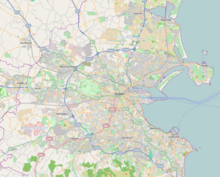
Back معركة كلونتارف Arabic Bitva u Clontarfu Czech Brwydr Clontarf Welsh Slaget ved Clontarf Danish Schlacht von Clontarf German Batalla de Clontarf Spanish Clontarfeko gudua Basque Clontarfin taistelu Finnish Bataille de Clontarf French Cath Chluain Tarbh Irish
| Battle of Clontarf | |||||||
|---|---|---|---|---|---|---|---|
| Part of the Viking Invasions of Ireland | |||||||
 Battle of Clontarf, oil on canvas painting by Hugh Frazer, 1826 | |||||||
| |||||||
| Belligerents | |||||||
| Forces of the High King of Ireland |
Kingdom of Dublin Kingdom of Leinster Kingdom of the Isles Earldom of Orkney | ||||||
| Commanders and leaders | |||||||
|
Brian Boru † Murchad mac Briain † |
Sigtrygg Silkbeard Máel Mórda mac Murchada † Sigurd the Stout † Brodir † | ||||||
| Strength | |||||||
| 5,000 men | ~7,000 men | ||||||
| Casualties and losses | |||||||
| 4,000 dead | ~6,000 dead | ||||||
Location within Dublin | |||||||
The Battle of Clontarf (Irish: Cath Chluain Tarbh) took place on 23 April 1014 at Clontarf, near Dublin, on the east coast of Ireland. It pitted an army led by Brian Boru, High King of Ireland, against a Norse-Irish alliance comprising the forces of Sigtrygg Silkbeard, King of Dublin; Máel Mórda mac Murchada, King of Leinster; and a Viking army from abroad led by Sigurd of Orkney and Brodir of Mann. It lasted from sunrise to sunset, and ended in a rout of the Viking and Leinster armies.
It is estimated that between 7,000 and 10,000 men were killed in the battle, including most of the leaders. Although Brian's forces were victorious, Brian himself was killed, as were his son Murchad and his grandson Toirdelbach. Leinster king Máel Mórda and Viking leaders Sigurd and Brodir were also slain. After the battle, the power of the Vikings and the Kingdom of Dublin was largely broken.
The battle was an important event in Irish history and is recorded in both Irish and Norse chronicles. In Ireland, the battle came to be seen as an event that freed the Irish from foreign domination, and Brian was hailed as a national hero. This view was especially popular during English rule in Ireland. Although the battle has come to be viewed in a more critical light, it still has a hold on the popular imagination.[2]
- ^ Kendrick, Sir Thomas D. (24 October 2018). A History of the Vikings. Routledge. p. 298. ISBN 978-1-136-24239-7.
- ^ Downham, Clare. "The Battle of Clontarf in Irish history and legend". History Ireland.
© MMXXIII Rich X Search. We shall prevail. All rights reserved. Rich X Search

